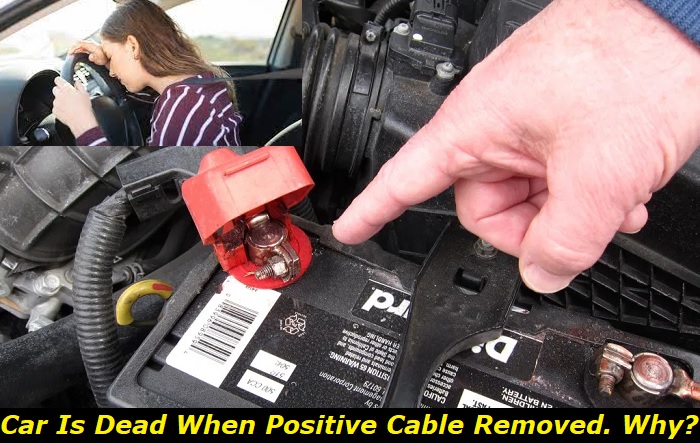There's a good reason why removing the positive (+) battery cable is such a no-no when tinkering with your auto. This is why we have constantly reminded everyone to always start with the negative (-) cable when disconnecting the battery no matter if they're just doing regular maintenance with some critical parts of their vehicle or replacing the battery.
Electrical power supply problems highlights
- DIY repairs:possible (sometimes)
- Tools needed:electrical tools,basiccar repair tools
- Commonreasons:battery or alternator problems, wiring issues, power distribution problems
- Time to repair:2 - 5 hours
- Price for parts:$10 - $350
- Can you drive?In most cases, no
- Alternative solutions:jumping, roadside assistance

Primary Reason for a Car Dying When the Positive Cable is Removed
Battery arcing is an electrical discharge that occurs when the positive battery cable is disconnected from the vehicle's battery before the negative battery cable. This arcing is caused by the built-up static electricity on the cable, and it can be dangerous because it produces a spark that could potentially ignite any flammable materials in the vicinity.
An electric arc is caused by a flow of electricity across an air gap, or any other type of gap (for example, between two conductive surfaces), which is greater than the breakdown voltage of the gap. The breakdown voltage is a measure of the amount of electric field needed to cause an arc to form across the gap.
When the electric field strength is sufficient, electrons are accelerated across the gap, carrying energy with them and ionizing the air along the way. This ionized air forms a plasma, and the current of electrons is sustained by the application of a voltage across the gap.
Battery arcing can cause serious damage to the components of the vehicle, such as the battery, alternator, fuse box, wiring, car computer, and other related electrical connections. Damage from arcing can range from a decrease in battery life to a complete meltdown and short circuit of the system.
Arcing can cause the terminals of the battery to corrode, leading to a decrease in the car's ability to hold a charge or even start the engine. It can also cause the alternator to overheat and fail, and can cause fuses to blow and wiring to melt. In extreme cases, arcing can cause a fire.
To prevent arcing when disconnecting the battery, always detach the negative cable before the positive cable when servicing your vehicle. Likewise, make sure that the battery cables are clamped down well prior to the operation of your auto.
Symptoms of Battery Arcing that You Should Watch Out For
You can easily see the electric arc if you are directly working on your engine bay through the sparks it produces. However, as mentioned earlier, there may be times when the positive battery cable loosens up on its own while you are behind the wheel.
This could be due to a break in its connector or wear and tear taking its course. Therefore, you should be able to diagnose the early symptoms of this potentially dangerous situation before it gets any worse.
The signs may include one or more of the following elements:
- The car suddenly dies down.
- The lights start to dim or flicker while the other electrical components are starting to malfunction.
- Crackling or buzzing sounds can be heard coming from the engine bay.
- There's smoke coming from the hood.
- Burnt smell getting into the cabin via the air conditioning vents.
- Various warning lights in your dashboard may trigger, which can be related to the engine and/or the battery.
- The paint of the hood may display discoloration, dark spots, or melting.
- There may be signs of sparks or flashes under the hood.
- The metal or plastic components of the hood may start bulging.
- At worst, a sign of fire may be evident.
The First Few Things You Must Do Upon Noticing Possible Signs of Battery Arcing
Probably, the most dangerous scenario where this could take place is when you are driving. So, when it does happen while you're on the road, exercise the following safety precautions:
- Don't panic.
- When driving, slowly maneuver the vehicle safely on the side of the road. Do not stop your vehicle abruptly in the middle of the highway as it may risk the chance of other unsuspecting vehicles ramming into yours.
- As much as possible, stop the vehicle in a safe spot on the side of the road with utmost caution and switch off the ignition.
- In the event that the arcing has caused your vehicle to stall in the middle of the road, safely exit it while signaling the incoming traffic of your emergency. Carefully wade your way to the side of the road.
- Make sure that your passengers, if there are any, have already safely disembarked the vehicle before going further.
- Call emergency services for assistance. You may also ask a companion to do this for you should you choose to follow the optional steps in this list.
- Optionally, if it's only safe to do so, wrap your hand with a thick layer of clothing or wear insulation gloves and try to remove the negative battery cable. However, if the sparks are already way too dangerous and there's a high risk of fire, skip this step and proceed to the next item on this list.
- In case of fire and you happen to have a portable fire extinguisher in your auto, be sure to use it. Do not douse your engine with water as it may increase your risk of electrocution if there's an open circuit. Again, skip this if you think that further action can pose danger to yourself.
- Remove any combustible materials from the vehicle if it's only safe to do so. If it's not, don't be a hero and get yourself to safety.
- At this point, it's best to move away from the vehicle and stay clear of it until help arrives. The sparks have a chance to ignite the flammable components of your vehicle, especially the parts where the fuel and other combustible fluids flow.
- Warn other people in the vicinity to stay away from the vehicle.
- Position an early warning device to where your vehicle has stalled if it's only safe to do so.
- Calmly wait until emergency services arrive.
Possible Damages and Repairs Needed After Battery Arcing
If you're lucky enough to dodge a potential disaster stemming from this problem, there are still certain parts that may directly suffer from damages due to the arcing incident.
Here's a list of the parts that are first to take a hit in this situation:
1. Battery
The battery is most likely the culprit of this problem, so it needs to be replaced for sure.
2. Fuses
Fuses usually burn out when an intense electrical surge overloads them, so they'll need to be replaced too.
3. Cables and wiring
These may start melting down or getting burned due to the arcing incident. They will have to be changed as well.
4. Distributor cap
This component usually bursts open due to heat buildup resulting from a battery arcing incident. Buy a new one if it has been damaged.
5. Spark plugs
If the incident has caused your spark plug's ceramic insulator to melt, you'll need to replace the parts as well.
6. Starter motor
The starter motor may be a bit more tedious since it involves disassembling the whole unit, but you will still have to change this if you want your vehicle up and running again.
7. Alternator
Similar to the starter motor, it involves a lot of work too so make sure that you check all its components thoroughly before reassembly. Have them replaced if necessary.
It's best to adjust all these parts accordingly since they are connected in one way or another. To ensure that your vehicle is running well and safely, be sure to have these parts repaired or replaced after an arcing incident. It's always better to be safe rather than sorry.
Depending on the gravity of the electrical surge in your vehicle or if such has resulted in fire, there may be more parts that may need to be fixed or replaced. For a good measure, have your auto diagnosed by a professional mechanic or technician after such an event.
Possible Consequences of Not Repairing Damaged Parts After Battery Arcing
If you don't repair the aforementioned parts, there are some severe consequences that may arise. Here's a list of possible effects:
1. Car won't start
The battery is the main power source of your vehicle so having it damaged can directly affect its ability to start up.
2. Electrical problems
If you didn't repair the rest of the affected components, chances are they will not work properly. This can lead to faulty electrical signals and may even cause a short circuit that will again, lead to more damage.
3. Decreased performance
The damaged components will not be able to produce optimum results if not repaired or replaced.
4. Risk of fire
If you didn't take the necessary precautions in dealing with an arcing incident, there is always a high risk of a possible fire breaking out.
Conclusion
To wrap things up, repair or replace any parts that have been damaged due to an arcing incident as soon as it's safe to do so. Doing this will ensure that your vehicle is working perfectly and safely at all times. If you're unsure of how to do these repairs, it's best to leave the job to a professional mechanic. This way you can be sure that the work is done properly and safely.
There are certain risks associated with this type of incident, and it's best to take necessary precautions in order to avoid further damage. When dealing with an arcing incident, make sure to move away from your vehicle immediately and call for help when safe to do so. Once everything is settled, repair or replace any parts that have been damaged due to the incident.
About the authors
The CarAraC research team is composed of seasoned auto mechanics and automotive industry professionals, including individuals with advanced degrees and certifications in their field. Our team members boast prestigious credentials, reflecting their extensive knowledge and skills. These qualifications include: IMI: Institute of the Motor Industry, ASE-Certified Master Automobile Technicians; Coventry University, Graduate of MA in Automotive Journalism; Politecnico di Torino, Italy, MS Automotive Engineering; Ss. Cyril and Methodius University in Skopje, Mechanical University in Skopje; TOC Automotive College; DHA Suffa University, Department of Mechanical Engineering






Add comment